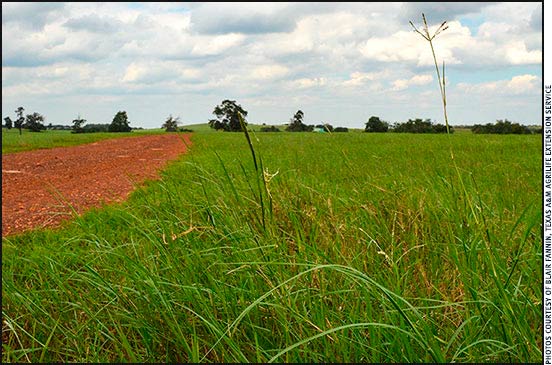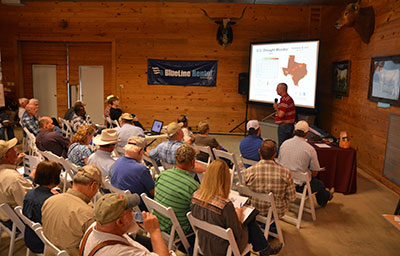
Forage’s Role in Rebuilding
Ranchers hear key factors to growing forage at symposium focused on rebuilding the beef herd.
Ranchers should be mindful of three important components of pasture health when considering restocking beef cattle, according to a Texas A&M AgriLife Extension Service expert.
Larry Redmon, AgriLife Extension state forage specialist in College Station, said water, fertilizer and protection are important factors to growing and maintaining forages in pastures. Redmon was one of several featured speakers at the recent beef herd rebuilding symposium at Camp Cooley Ranch near Franklin, Texas.
“The recent 2014 U.S. Drought Monitor map is looking better, but we still have parts of the state in drought,” he said. “The long-range forecast has much of the state improving and starting to ease back into higher production. As you are making your decisions to restock, we may not be out of the woods completely. Climatologists say these drought cycles typically last for 22-25 years. Just be cautious before testing the waters.”

Larry Redmon, AgriLife Extension state forage specialist in College Station, Texas, discusses forage management at the recent beef herd rebuilding symposium at Camp Cooley Ranch near Franklin.
Redmon said water is the No. 1 important factor for growing forage. Next, for Bermuda grass or any hay field, is fertilizer. He warned about managing winter pastures when overseeding warm-season perennial grass fields.
“You want to remove winter pasture before green-up,” he said. “If you don’t, the winter pasture can inhibit photosynthesis. For example, an ungrazed ryegrass pasture will intercept the light and prevent warm-season grasses from being able to grow as they break winter dormancy. Bermuda grass begins active growth when nighttime temperatures are consistently 60° Fahrenheit, and all winter pasture should be removed prior to that time.”
Redmon said to remove the winter grass, ranchers have the options of either grazing it out or baling it.
Fertility was another important factor discussed. Redmon stressed to attendees to get a soil sample to determine what deficiencies there are in the soils. This can save money when it comes to purchasing fertilizer by making sure to purchase only the recommended amounts and buying blends that are appropriately needed for the pasture.
Finally, protection is important as well. Having ample stands of forage residue on the ground helps protect the soil from erosion and allows water and nutrients to be captured and infiltrate the soil. During the 2011 drought, Redmon said, one rancher elected to keep his cattle and continued to purchase expensive hay, allowing his cows to continually graze down the forage. He said another rancher nearby chose to sell most of his cows, which allowed his pastures to recover more rapidly.
“By maintaining adequate amounts of forage residue, ranchers can make their place a sponge and actually capture limited amounts of rainfall. Forage residue in the pasture also prevents loss of fertilizer nutrients, pesticides and bacteria into the local waterbody,” Redmon said.
Redmon advised producers to pay attention to weeds, which can inhibit recovery due to competition for moisture, sunlight and nutrients.
“You need to also pay attention to grasshoppers, fall armyworms, and the newest Bermuda grass forage pest — the Bermuda grass stem maggot,” Redmon said. He said recent grasshopper infestations in some areas were 30 to 50 per square yard.
Redmon said Prevathon® is one pesticide that has shown effective results for grasshoppers and fall armyworms with no grazing or haying restrictions.
He advised ranchers to visit http://forages.tamu.edu for more educational resources on forage management and to sign up for Forage Fax, an online newsletter available at http://foragefax.tamu.edu for the latest information bulletins.
The Rebuilding the Beef Herd Symposium was sponsored by the AgriLife Extension offices in Robertson, Brazos, Burleson, Falls, Freestone, Leon, Limestone, Madison and Milam counties in cooperation with the Brazos Area Hay Producers Association.







